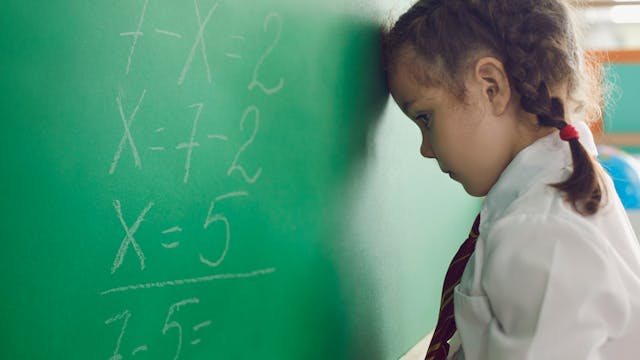Picture the following: A student volunteers to answer a math question in an elementary school classroom. The teacher knows from working with the student previously that although she can easily follow the algorithmic steps of the math problem, she struggles with her reasoning and ability to make sense of the steps she is taking.
As she struggles to answer the question, two other students begin to whisper questions in her ear. Their questions help to create a situation that allows her to reflect on connections between the algorithmic steps she knows to solve the math problem and further her reasoning about why those steps work. Suddenly, after thinking about her classmates' questions, she beams and proudly walks the class through her correct reasoning for the math problem.
In this situation, the teacher has made an effort to know each and every student, the math knowledge they bring to the lesson and how that knowledge can be used to advance learning more complex math. The teacher has also set up a classroom that nurtures curiosity and questioning that leads to learning.
As hopeful as this scenario sounds, mathematics is a struggle for many learners. Nationally, mathematics achievement on average remains low with glaring, persistent inequities across racial and ethnic groups. According to the National Assessment of Educational Progress in 2022, students in fourth and eighth grade had the largest decline in mathematics achievement since 1990. Furthermore, data shows that only 35 percent of fourth grade students were proficient in mathematics, dropping to 26 percent proficiency at the eight grade level. As a result, the achievement gap between white students and Black and Hispanic students has increased.
Many efforts to advance students’ mathematical achievements largely focus on fitting grade-level lessons to an entire class of students. Students are expected to get the mathematics by participating in the lesson activity; however, this approach ignores differences in how students leverage their own knowledge in each lesson to advance their learning.
To foster success in mathematics, we need to consider what students already know as a way to advance what they don’t yet know.
Shifting Mathematical Thinking
Learning mathematics is a cognitive process grounded in a learner’s experience. The change from not knowing to learning a mathematical concept, also known as reorganization, occurs when a student uses their existing ideas and understanding as a way to develop more advanced ideas.
Reorganization occurs through two related mental processes that psychologist Jean Piaget referred to as assimilation and accommodation. Assimilation is how we, including students, see the world with the current knowledge we have. Accommodation is how we learn and change our lens to reorganize what we know into more advanced thinking. Facilitation of learning from a teacher can greatly assist in helping a student go from assimilation to accommodation of a new mathematical concept.
To promote reorganization, create a more learner-centered classroom and shift students’ mathematical thinking, instruction should include both a Second Order Model and consideration of social and cultural contexts.
Second Order Model
A Second Order Model (SOM) is a teacher’s recognition of their students' mathematics conceptions and the differences between the teacher’s mathematical thinking and the student’s mathematical thinking, the end product being assimilation. By inferring into and understanding the different conceptions students have, teachers can cater to specific learning needs, assess progress towards the intended mathematical goal and adjust instruction as a necessary way to advance students’ conceptions.
As a facilitator of mathematical learning, one needs to develop a clear distinction between “my students reason the same way I do, so I can teach them as I understand it” and a SOM that instead says, “my students have different conceptions than I do, so I need to consider their understanding to guide my instruction”. As teachers develop a SOM, they are more aware of students’ mathematical operations, and their classroom can become more learner-centered. A teacher who operates with a SOM can choose the most appropriate activities and tools for advancing students' learning from an asset-based perspective, taking students from what they know to what they can readily learn next.
Social and Cultural Contexts
As psychologist Lev Vygotsky has shared, learning mathematics is also social and cultural. Social interaction within a classroom context serves as a way for learners to create understanding through increased awareness of multiple cultural perspectives and meanings negotiated through interaction. Specifically, social interaction is an important component for the development of a mathematical concept and can help a learner’s cognitive process of reorganization by providing situations that lead to questions, disruptions and reflections.
To support a learner in reorganizing their existing understanding to more advanced concepts, social interactions must include teacher facilitation, which is specifically designed to support learning that allows students to use existing understanding of mathematics as a way to engage in high-level processes of thinking, reasoning and problem-solving of more advanced mathematics.
Recognizing What Students Already Bring to Learning
As former teachers and education leaders, we have a duty to give students opportunities to advance their mathematical reasoning in learner-centered classrooms. To provide such opportunities for learner-centered mathematics classrooms, it is important to understand how learning occurs, recognize students' assets and existing understanding, and create awareness of the differences between teachers’ mathematical thinking and students’ mathematical thinking.
As we think about the future of math classrooms, we continue to explore how academic standards and cultural, social and emotional development intersect to support learning mathematics. We look forward to a future that recognizes learners’ existing math knowledge as a starting point to think about new ideas and concepts.


